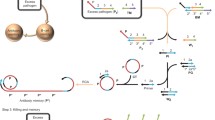Abstract
We propose that bio-inspired algorithms are best developed and analysed in the context of a multidisciplinary conceptual framework that provides for sophisticated biological models and well-founded analytical principles, and we outline such a framework here, in the context of AIS network models. We further propose ways to unify several domains into a common meta-framework, in the context of AIS population models. We finally hint at the possibility of a novel instantiation of such a meta-framework, thereby allowing the building of a specific computational framework that is inspired by biology, but not restricted to any one particular biological domain.
Access this chapter
Tax calculation will be finalised at checkout
Purchases are for personal use only
Preview
Unable to display preview. Download preview PDF.
Similar content being viewed by others
References
Aicklen, U., Bentley, P., Cayzer, S., Kim, J., McLeod, J.: Danger Theory: The Link Between AIS and IDS? In: Timmis, J., Bentley, P.J., Hart, E. (eds.) ICARIS 2003. LNCS, vol. 2787, pp. 156–167. Springer, Heidelberg (2003)
Bersini, H.: Immune Network and Adaptive Control. In: Proc. First European Conference on Artificial Life, pp. 217–226. MIT Press, Cambridge (1991)
Bersini, H.: Reinforcement and Recruitment Learning for Adaptive Process Control. In: Proc. Int. Fuzzy Association Conference (IFAC/IFIP/IMACS) on Artificial Intelligence in Real Time Control, pp. 331–337 (1992)
Bersini, H., Varela, F.J.: The Immune Learning Mechanisms: Reinforcement, Recruitment and Their Applications. In: Paton, R. (ed.) Computing with Biological Metaphors, pp. 166–192. Chapman & Hall, Boca Raton (1994)
Bonabeau, E.W., Dorigo, M., Theraulaz, G.: Swarm Intelligence: from natural to artificial systems. Addison-Wesley, Reading (1999)
Bradley, D.W., Tyrrell, A.M.: Immunotronics: Novel Finite State Machine Architectures with Built in Self Test using Self-Nonself Differentiation. IEEE Transactions on Evolutionary Computation 6(3), 227–238 (2002)
de Castro, L.N., Timmis, J.: Artificial Immune Systems: A New Computational Intelligence Approach. Springer, Heidelberg (2002)
de Castro, L.N., Von Zuben, F.J.: The Clonal Selection Algorithm with Engineering Applications. In: Workshop on Artificial Immune Systems and Their Applications, Genetic and Evolutionary Computation Conference, pp. 36–37 (2000)
de Castro, L.N., Von Zuben, F.J.: aiNet: An Artificial Immune Network for Data Analysis. In: Abbass, H.A., Sarker, R.A., Newton, C.S. (eds.) Data Mining: A Heuristic Approach, ch. XII, Idea Group Publishing, USA (2001)
Farmer, J.D., Packard, N.H., Perelson, A.S.: The Immune System, Adaptation, and Machine Learning. Physica D 22, 187–204 (1986)
Forrest, S., Perelson, A., Allen, L., Cherukuri, R.: Self-Nonself Discrimination in a Computer. In: Proc. IEEE Symp. on Research in Security and Privacy, pp. 202–212 (1994)
Freitas, A., Timmis, J.: Revisiting the Foundations of Artificial Immune Systems. In: Timmis, J., Bentley, P.J., Hart, E. (eds.) ICARIS 2003. LNCS, vol. 2787, pp. 229–241. Springer, Heidelberg (2003)
Gammaitoni, L., Hanggi, P., Jung, P., Marchesini, F.: Stochastic Resonance. Rev. Mod. Phys. 70(1), 223–287 (1998)
Goldberg, D.E.: Genetic Algorithms in Search, Optimization and Machine Learning. Addison-Wesley, Reading (1989)
Hightower, R.R., Forrest, S.A., Perelson, A.S.: The Evolution of Emergent Organization in Immune System Gene Libraries. In: Eshelman, L.J. (ed.) Proc. 6th Int. Conf. on Genetic Algorithms, pp. 344–350. Morgan Kaufmann, San Francisco (1995)
Holland, J.H.: Adaptation in Natural and Artificial Systems. University of Michigan Press (1975)
Janeway Jr, C.A., Medzhitov, R.: Innate immune recognition. Ann. Rev. Immunol. 20, 197–216 (2002)
Jerne, N.K.: Towards a Network Theory of the Immune System. Ann. Immunol (Inst. Pasteur) 125C, 373–389 (1974)
Kourilsky, P., Truffa-Bachi, P.: Cytokine fields and the polarization of the immune response. Trends Immunol. 22, 502–509 (2001)
Neal, M.: Meta-stable Memory in an Artificial Immune Network. In: Timmis, J., Bentley, P.J., Hart, E. (eds.) ICARIS 2003. LNCS, vol. 2787, pp. 168–180. Springer, Heidelberg (2003)
Matzinger, P.: The danger model: a renewed sense of self. Science 296, 301–305 (2002)
Medzhitov, R., Janeway Jr., C.A.: Decoding the patterns of self and nonself by the innate immune system. Science 296, 298–300 (2002)
Mitchell, M.: An Introduction to Genetic Algorithms. MIT Press, Cambridge (1996)
Padgett, D.A., Glaser, R.: How stress influences the immune response. Trends Immunol. 24, 444–448 (2003)
Perelson, S.: Immune Network Theory. Imm. Rev. 110, 5–36 (1989)
Perelson, S.: Modelling viral and immune system dynamics. Nat Rev. Immunol. 2, 28–36 (2002)
Romanyukha, A.I.: Yashin. Age related changes in population of peripheral T cells: towards a model of immunosenescence. Mech Ageing Dev. 124, 433–443 (2003)
Sprent, J., Surh, C.D.: T cell memory. Ann. Rev. Immunol. 20, 551–579 (2002)
Taylor, D., Corne, D.: An Investigation of the Negative Selection Algorithm for Fault Detection in Refrigeration Systems. In: Timmis, J., Bentley, P.J., Hart, E. (eds.) ICARIS 2003. LNCS, vol. 2787, pp. 34–45. Springer, Heidelberg (2003)
Timmis, J.: Artificial Immune Systems: A Novel Data Analysis Technique Inspired by the Immune Network Theory, Ph.D. Dissertation, Department of Computer Science, University of Wales (September 2000)
Varela, F., Coutinho, A., Dupire, B., Vaz, N.N.: Cognitive Networks: Immune, Neural and Otherwise. In: Perelson, A.S. (ed.) Theoretical Immunology, part 2, pp. 359–375. Addison-Wesley, Reading (1988)
Author information
Authors and Affiliations
Editor information
Editors and Affiliations
Rights and permissions
Copyright information
© 2004 Springer-Verlag Berlin Heidelberg
About this paper
Cite this paper
Stepney, S., Smith, R.E., Timmis, J., Tyrrell, A.M. (2004). Towards a Conceptual Framework for Artificial Immune Systems. In: Nicosia, G., Cutello, V., Bentley, P.J., Timmis, J. (eds) Artificial Immune Systems. ICARIS 2004. Lecture Notes in Computer Science, vol 3239. Springer, Berlin, Heidelberg. https://doi.org/10.1007/978-3-540-30220-9_5
Download citation
DOI: https://doi.org/10.1007/978-3-540-30220-9_5
Publisher Name: Springer, Berlin, Heidelberg
Print ISBN: 978-3-540-23097-7
Online ISBN: 978-3-540-30220-9
eBook Packages: Springer Book Archive




